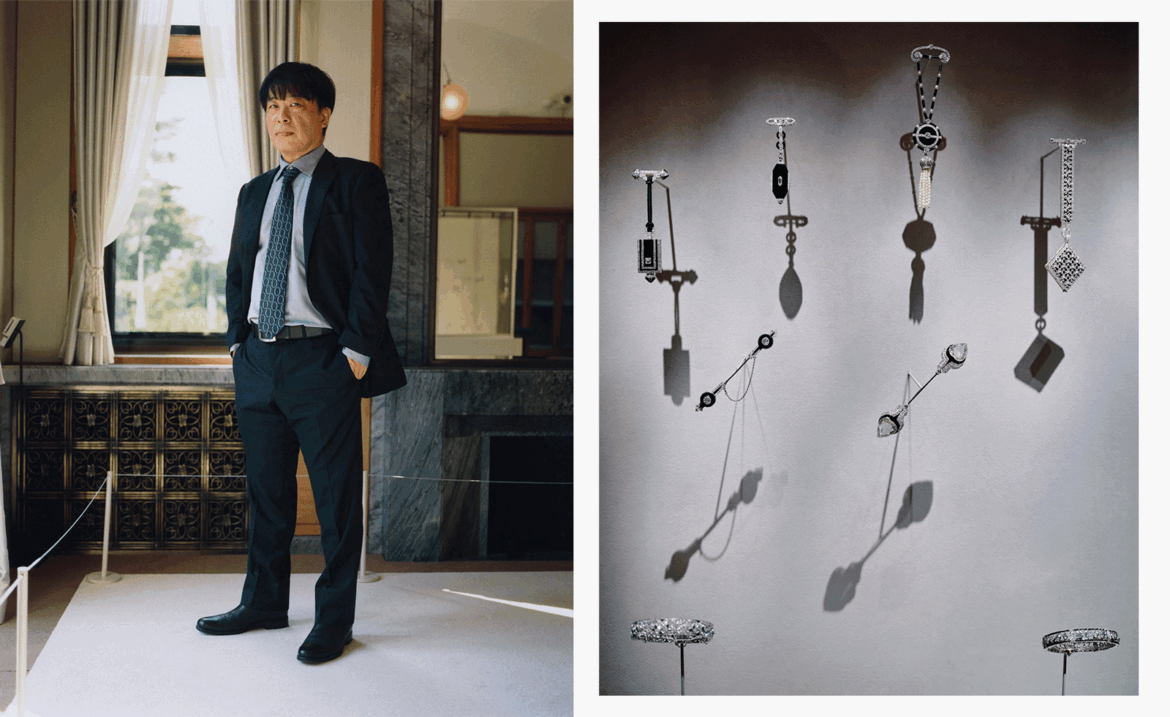It is 1925, and Paris is in the midst of an art deco love affair. The International Exhibition of Modern Decorative and Industrial Arts, uniting 15,000 exhibitors from more than 20 countries, is in full swing on the banks of the Seine. The avant-garde showcase of jewellery, art and design is the pinnacle of art deco, championing a movement heavily inspired by African art and defined by a stylised geometry. For French jewellery house Van Cleef & Arpels, which scooped a Grand Prize for innovative jewellery design, it was a recognition of its mastering of the decorative arts.
Marking the event’s 100th anniversary, the maison is revisiting this watershed moment with an exhibition held at the former residence of Prince Asaka, now the Tokyo Metropolitan Teien Art Museum. The epitome of art deco style, the palace was built in 1933 in Tokyo’s Shirokanedai district for Prince and Princess Asaka, who had recently returned from three years in Paris. They had visited the 1925 art deco exhibition; inspired by what they saw, they asked Henri Rapin, who had overseen the interior design of the event’s pavilions, to bring his characteristic style back to their main residence. Among the artists he employed to bring his vision to life was glassmaker René Lalique,whose beautiful light fittings can still be admired in the building today. After the war, the palace became the official residence for Japan’s prime minister and foreign minister, before becoming an art museum in 1983.

Van Cleef & Arpels’ earliest art deco designs are on display in the museum’s Great Dining Hall, featuring a botanical wall relief by Léon Alexandre Blanchot
(Image credit: Den Niwa)
An elegant marriage of French art deco and minimalist Japanese design, the space was named after the lush gardens that surround it. Faithfully maintained, in 2014 the museum gained a new annexe, designed by architect and photographer Hiroshi Sugimoto, which encompasses modern exhibition spaces, as well as a café and shop.

Van Cleef & Arpels’ ‘Entwined Flowers, Red and White Roses’ bracelet, which won a Grand Prize at the 1925 International Exhibition in Paris, is illuminated by a René Lalique fruit-motif pendant in the Great Dining Hall
(Image credit: Den Niwa)
The current exhibition, ‘Timeless Art Deco with Van Cleef & Arpels High Jewelry’, unites 250 pieces of historical jewellery, watches and precious objects, including the Grand Prize-winning ‘Entwined Flowers, Red and White Roses’ bracelet. Many of the pieces on display, some for the first time, were crafted between 1910-1930, uniting distinctive design details, such as sharp geometrical lines, intricate openwork, sculpted gold and luscious enamel. The emergence of an aesthetic can be traced throughout the displays, from the stylised floral motifs paying homage to Asian influences, through to the graphic diamond three-dimensional forms, designed to snake their way fluidly around the wearer. In other pieces, functionality rules, such as in a sleek minaudière vanity case created in 1933, or in the ‘Zip’ necklace, an innovative design, patented in 1938, that celebrated the usually hidden inner workings.

In the museum’s Hiroshi Sugimoto-designed annexe, the exhibition’s Garden of Savoir-Faire section showcases Van Cleef & Arpels’ mastery of techniques such as enamelling in floral-and animal-inspired motifs
(Image credit: Den Niwa)
The design of the exhibition itself is also crucial to a story that marries form and function. It was something that preoccupied architect Tezzo Nishizawa, founder of his eponymous Tokyo-based practice, who oversaw the scenography. ‘Consider the scale between the architecture of the museum and the small jewellery pieces,’ he says, on the challenges of creating an immersive and enjoyable environment. ‘We have to eliminate this gap naturally, so we were thinking about how we can harmonise the two. There was a wish to have the exhibition cases neutral, but that usually becomes white or black. Here, there are so many colourful and decorative pieces, monotone would distract from the beauty of the jewellery. It became a very good opportunity for me to think about the new definition of neutrality, and it resulted in the main theme of this scenography and of the exhibition itself.’
Nishizawa draws parallels between the worlds of jewellery and architecture, creating forms and shapes that emphasise both but without distracting from the experience. ‘The team at Van Cleef & Arpels all follow the same philosophy and have the same mission. Working with them has greatly inspired my own work. I have discovered that art deco is very accessible to everyone, even today, and it is flexible enough to accept different perspectives and different definitions of beauty.’
‘Timeless Art Deco with Van Cleef & Arpels High Jewelry’ is on show until 18 January at the Tokyo Metropolitan Teien Art Museum, teien-art-museum.ne.jp, vancleefarpels.com
This article appears in the December 2025 Entertaining Issue of Wallpaper* , available in print on newsstands, on the Wallpaper* app on Apple iOS, and to subscribers of Apple News + from 6 November. Subscribe to Wallpaper* today
TOPICS
Van Cleef & Arpels
Tokyo


AloJapan.com